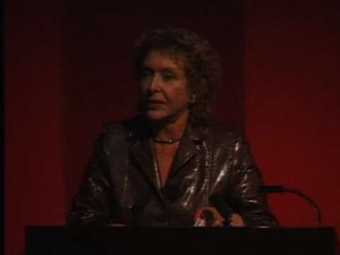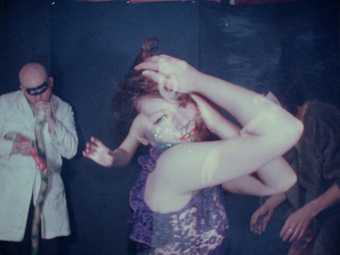In that opaque cube, one light: the film, the screen? Yes, of course. But also, (especially?), visible and unperceived, that dancing cone which pierces the darkness like a beam
Roland Barthes, On Leaving the Movie Theatre, p.347
The projection of light rays has long been a source of fascination for artists and scientists alike, discussed by Aristotle and apparent in Leonardo da Vinci’s interest in the semblance of life projected into the dark chamber of the camera obscura. The desire to channel and direct light goes back to the study of optics which characterised the scientific and technological developments of sixteenth- and seventeenth-century Europe. And the devices cultivated through science were transformed into spectacular forms of popular entertainment that held audiences in thrall to the magic lantern or the apparitions that Étienne-Gaspard Robertson conjured from the smoke-filled projections of his phantasmagoria. Several centuries later, Barthes’s eulogy to cinemagoing crystallises the contradictory nature of the film projection in our experience of cinema. ‘Visible and unperceived’, its rays play a vital role as the conveyers of information to the screen, yet its significance is forgotten as the viewer’s attention is turned towards the flicker of images, rather than the beam above their heads.
However, occurring outside the auditorium, among the freely moving audiences of alternative art spaces and artists’ studios during the 1960s and 1970s, projection was being reinstated as a visible component of interdisciplinary art practices, finding new potential at the confluence of performance, sculpture and installation. In Lis Rhodes’s 1975 double-screen film Light Music, the role of projection is re-imagined – no longer hidden in the projectionist’s booth, nor secondary to the narratives on the screen. From an oblique angle, upwards from opposite positions on the floor, the two projectors fill the space between them with shafts of light made discernible when the spectator, as well as dust, smoke and other matter, are caught in their path. In a direct correspondence between sound and image, the minimal electronic soundtrack which vibrates through the gallery space – and the body of the observer – is generated by the horizontal black and white stripes depicted on the screens. Their pulsating monochrome scores materialise in transit on their journey to the screens, not as solid cones of light, but as fluctuating patterns of splintered beams; not a constant light, but one moving in and out of materiality, to the unearthly sounds emitted from the projectors. Rhodes seems to make palpable the notion of the soundwave, calling to mind not only the hidden synchronicities occurring between projector and screen, but light and sound’s fundamental properties.
First shown at the London Filmmakers Cooperative in 1975, Light Music offers evidence of a new mode of cinematic projection experience, also termed ‘expanded cinema’, rooted in the radicalised political environment of the period and the increasing dominance of media technologies such as television, film and video. Nine years before, in the chart devised by the Fluxus artist George Maciunas for the 1966 edition of Film Culture magazine dedicated to the ‘Expanded Arts’, links are drawn from contemporary practitioners in music and art such as John Cage and Nam June Paik to precedents and protagonists as various as kinesthetic theatre, Bauhaus and vaudeville. Maciunas’s map shows that the difficulty of containing the extent of expanded cinema’s spheres of influence and interconnection reflects the unruly nature of this hybrid art activity.
As the art critic and historian Liz Kotz has since queried, how can a ‘set of terms’ or ‘historical trajectories, defining conditions or artistic principles’, be brought to bear on ‘a field of activity that aggressively accumulates practices ranging from abstract painting, post-Cubist collage and kinetic sculpture to experimental theatre, dance and electronic music’? Indeed, the term expanded cinema has been used to encompass some seemingly very diverse combinations of film and other media. It was first coined by the maverick underground filmmaker Stan VanDerBeek to explain his utopian vision of the promise of new media in the 1960s, rooted in the writings of Marshall McLuhan and the American counter-culture, but has also been applied to the confrontational combinations of film and performance by Peter Weibel and VALIE EXPORT in 1960s Vienna, as well as the shadow play, performance and multi-screen projections presented at the Filmaktion events at the Walker Art Gallery in 1970s Liverpool.
What can be seen to unite these diverse approaches was the desire to encourage a more active and participatory relationship between the viewer and their film experience, one which reflected the the political agency of the 1960s counter-cultural body in action, as seen at sitins and on marches proclaiming the liberalised sexuality and lifestyle of the anti-establishment. The burning books of John Latham’s Skoob Towers in mid-1960s London and the visceral performing bodies of Carolee Schneemann’s Meat Joy 1964 in New York attest to how the happenings and performances which developed from this period of dissent on both sides of the Atlantic rethought art practice outside the gallery space, emphasising, as the historian Stuart Laing notes, the new importance of the live event, where ‘the cultural process (‘performance’, ‘happening’) rather than the fixed product was a central feature of much would-be revolutionary culture of the decade’.
Within this context, film projection now acts as a potent reminder that cinema is a live experience of the present moment, in which the beam of light becomes the crucial point of convergence between the mechanics of the projector and the process unfolding in the space and time experienced by the viewer, rather than an on-screen protagonist. This new conception is clear in the film-maker Malcolm Le Grice’s 1972 text Real TIME/SPACE, when he writes of the ‘projection event” as ‘the primary reality’, ‘current tangible point of access’ and ‘experiential base through which any retrospective record, reference or process is to be dealt with by the audience’. The article reflects his concerns about what he saw as the fixation upon on-screen drama encouraged by mainstream modes of spectatorship, describing it as the ‘passive subjectivity to a prestructured substitute and illusory reality which is the normal situation for the audience of the commercial film’.
Le Grice’s critique goes beyond the page to explore in practice how to break the spell of cinema’s narrative pleasures, taking his strategies from contemporary developments in performance and sound experiment, in which the process of projection served as the point of intersection for a new dynamic between the performing body, the audience and the film apparatus. This included his own ‘shadow play’ performances, such as Horror Film 1 1971, in which his body intersects the beam to create a play of coloured light and shadow on the wall, or Annabel Nicolson’s Jaded Vision 1973, where a paper bird dangled in front of the beam is transformed into shadowy life as it is animated into movement by the artist, accompanied by a keening bird-like sound created in the feedback of a spinning microphone. Works such as these, where the experience of cinema is transformed from an image on-screen into an interplay of projected light and performing body, could be seen as a creative means of investigating the question of illusion in cinema, by returning to an earlier moment of pre-cinematic spectacle before the industrial structures and narrative fictions of the mainstream industry held sway. As Le Grice later noted: ‘We were in a sense re-inventing or re-working cinema as an invention. We were, however, not fully conscious of that… but we were trying to see what the fundamentals of the cinema were.’
The series of events that flourished briefly in Britain in the early 1970s are testament to how Le Grice, Nicolson and the group of painters and sculptors associated to the modernist aesthetics and artisanal filmmaking of the London Filmmakers Co-operative developed these ideas into practice, creating a rich re-imagining of the potential of the film projection as an experience of a live event, emphasised by experimental uses of sound and the embodied presence of the performing filmmaker. Film actions such as these attempted to create a more active, participatory experience of cinema for their viewers, in which they would become alert to the dimensions of the gallery or auditorium around them, and the unfolding event occurring within it.
Access to the flexible spaces of the gallery, such as Gallery House, where a series of film action events took place in early 1973, also encouraged a conception of film projection closer to sculpture than conventional cinema, presenting us with some of the first examples of film installation in Britain. As the artist Gill Eatherley recalls: ‘The interesting thing there for me was the idea of building up something, starting from loops and bringing it off the screen down into the actual gallery situation and working with objects and movement.’ The multiple floor to ceiling projections of her film installation Sicher Heits 1973, for example, played throughout the day in the gallery to an audience who moved freely about the space to engage with the multiplied found footage images which looped and repeated the potent image of a torpedo in a wind tunnel, so that it appeared to twitch with malevolent life, ready for firing.
The year 1973 was the high point of activity for a wide group of British artist filmmakers such as Eatherley, in particular the Filmaktion events at the Walker Art Gallery. The seriousness with which this new mode of projected art was being taken was also apparent in the dedicated expanded film programmes later that year at the ICA, as part of the International Festival of Independent Avant-Garde Film. Here, British artists showed alongside European counterparts such as Wilhelm and Birgit Hein and American visitors associated with an earlier chapter of expanded cinema, such as Stan VanDerBeek. UK pioneers were also represented, including Jeff Keen, whose film performances since the 1960s had brought together destructive acts of artistic arson with a Pop art sensibility, combining pyres of burning dolls with drawings, cartoons and performance as his alter-ego Dr. Gaz.
Despite these compelling explorations, light projection never became fully established as a mode of practice, probably because of the ascendency of the video medium and the reluctance of cultural institutions, as well as commercial galleries, to show what was still negatively associated with entertainment cinema rather than the fine arts. As seminal rehabilitative exhibitions such as Into the Light: The Projected Image in American Art 1964–1977 at the Whitney Museum in 2001 and X Screen: Film Installations and Actions in the 1960s and 1970s at MUMOK in Vienna in 2004 confirm, it is only in recent years, when technological developments have determined that moving image projection has now become commonplace in the museum, and 16 mm film has taken on a new archival status in the face of its impending obsolescence, that interest has re-ignited in expanded cinema’s beguiling combination of radical intent and visual spectacle.
Furthermore, does expanded cinema define a history of past inter-media practices, or can we still apply it to the myriad combinations of film with performance, sound and sculpture through which current artists continue to resist categorisation? What of Untitled Two 2006, Emma Hart and Benedict Drew’s performance where a film strip runs through the frets of a guitar to produce sounds as elegantly austere as those of Rhodes’s Light Music? Consider how Kerry Tribe’s Critical Mass 2010 turns the lovers’ quarrel depicted in Hollis Frampton’s 1971 film of the same name into a live event, in which two performers amplify the cut-up soundtrack of the original, replaying its stutters and repetitions. Or the suspended projector of Mauricio Ancalmo’s film installation A Lover’s Discourse 2010, which spins counter to the motion of the record turntable to which it is tethered, casting its projected image of a lovers’ embrace in intermittent directions across the gallery wall. Recent works such as these might share with their predecessors of the 1960s and 1970s a recognition of film projection’s still unrealised potential as a live experience and sculptural form, and a medium in itself.


